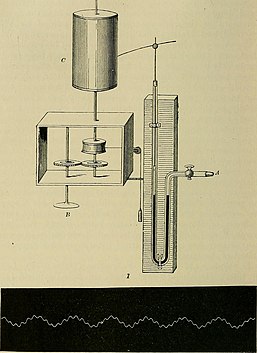Kymograph

| Kymograph | |
|---|---|
| MeSH | D007734 |
A kymograph (a Greek-derived name which means 'wave writer') is a device that draws a graphical representation of spatial position over time in which a spatial axis represents time. It basically consists of a revolving drum wrapped with a sheet of paper on which a stylus moves back and forth recording perceived changes of phenomena such as motion or pressure.[1][2]

The kymograph was initially a mechanical and hydraulic device, invented by German physiologist Carl Ludwig in the 1840s, and found its first use as a means to monitor blood pressure. The blood pressure was conveyed by hydraulics and levers to move a stylus that scratched a white trace into soot-covered paper on the revolving drum. Time is represented by the drum's rotation rate, and was recorded by a further stylus driven by a clock or tuning fork. The kymograph almost immediately became the central instrument in physiology and physiology education. Throughout the nineteenth and twentieth centuries, researchers and technicians devised many improvements to the device, plus numerous new sensory components, to measure a wide range of physiological phenomena such as breathing, muscle movement, speech. New detection and registration systems included electrical and electronic methods, and plotted in ink.[3]
Kymographs were also used outside medical science to measure atmospheric pressure, tuning fork vibrations, the functioning of steam engines, animal habits and the movement of molecules in cells.
See also
References
- ^ University of Toronto Scientific Instruments Collection. "Vertical Kymograph". www.psych.utoronto.ca. Retrieved 2017-04-29.
{{cite web}}: Cite has empty unknown parameter:|dead-url=(help) - ^ Science Museum. "Kymograph, London, England, 1925-1935".
{{cite web}}: Cite has empty unknown parameter:|dead-url=(help) - ^ Kwan, Alistair. ""Do not kill guinea pig before setting up apparatus": the kymograph's lost educational context". Teorie Vědy. 38: 301–335.
